Jonathan David is a 19-year-old forward playing for Gent in the Belgian First Division A. After a string of impressive performances from the Canadian teenager, this scout report will look to provide an insight into the young talent via objective, subjective and tactical analysis. Key contents will include an analysis of David’s background, Gent’s tactics, his playing style and data-driven comparisons with other players.
Background
Given David is still just 19 years old, his career history thus far is brief. David started as a 10-year-old for Gloucester Dragons in Ottawa, Canada. From there, he stayed in Canada, playing for Ottawa Gloucester Hornets and Ottawa Internationals for the remainder of his youth career. David turned professional as he signed for Belgian First Division team, Gent in 2018.
Given, David’s impressive performances, which will be discussed, it is interesting that Gent secured his signature as a professional, as opposed to an MLS team or another team from Europe. While the circumstances of the move and interest from other teams is unknown, credit is due to Gent’s scouting and recruitment team who identified the player as an emerging talent from a relatively unknown source and committed to signing him.
Since his professional debut at the age of 18, David has scored 16 goals and four assists in 38 appearances for Gent. He has established himself in the first team, far before many would expect given the adaptation and growth needed for a young player turning professional and moving country. When in the first team, he contributed significantly, as highlighted by his numbers, which will be delved into more later in the article.
Jonathan David’s rise in domestic competition has coincided with the rise of his international career, again highlighting the player as an exciting prospect. The attacker played three times for the under 17’s, scoring two goals, and twice for the under 23’s with no return. His call up to the senior squad in 2018 matched his professional signing and his best run of international form. To date, the Canadian has scored 11 goals in 10 appearances for the national team.
His role at Gent
Given his output of 16 goals in 38 appearances, one would assume that the player is a natural striker, however, David is an attacker who operates behind a central striker or striking partnership. Given his role and his output, he could also be termed a shadow striker. This is illustrated with Gent’s average formation below. Gent utilised a 4-2-3-1 system frequently, with alternatives including a 4-3-1-2 or 4-4-1-1, all supporting the use of David in the hole or number ’10’ role behind a striker(s).
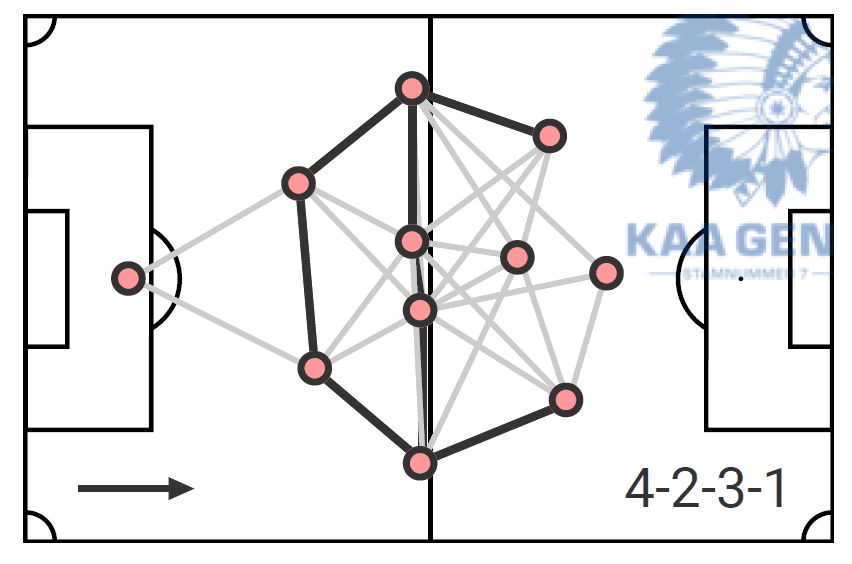
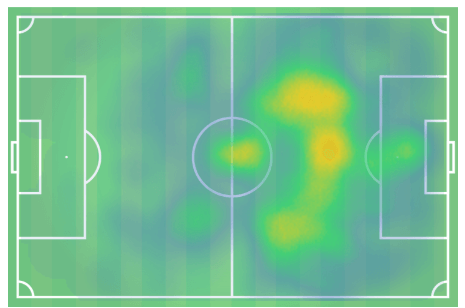
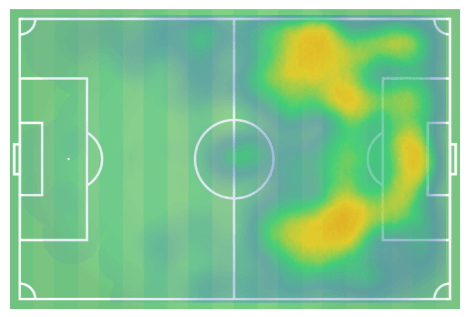
18/19 season
By taking a look at the breakdown of Jonathan David on the 18/19 season, his first full season at Gent, we can see that his main contribution in terms of output is his goals. These stats will be presented in isolation in order to determine David’s playing style. Comparisons and rankings with alternative Belgian First Division A players will add more context later.
| Minutes | Full appearances (based on minutes played) | Goals | Assists | xG | xA | |
| Total | 2119 | 23.5 | 12 | 2 | 7.95 | 3.3 |
| Per 90 | N/A | N/A | 0.51 | 0.08 | 0.34 | 0.14 |
The player has scored 12 goals from just under 24 matches, averaging a goal every two games. This is interesting and provides insight into David’s role in the number ‘10’ slot. His actual goals versus expected goals are inflated, meaning the player scored more than expected based on the quality of his chances. Therefore, a long term regression to the mean, for example, seven or eight goals from 7.95 expected in this instance, is likely. However, if an over-performance in terms of xG continues over a large sample, this could indicate above-average finishing ability. So far, his over-performance is impressive but is considered to be down to factors including luck, form and poor opposition goalkeeping performance, rather than being indicative of superior finishing versus the mean. It will be interesting to see if Jonathan David’s over-performing actual versus expected goals continues at the end of the 19/20 season and beyond.
Given his goal total and per 90 statistics are much higher than the two assists and 0.08 assists per game metrics, we can presume that David is not the creative spark within the Gent team, or, the spark that would typically be expected of the player in the number ‘10’ role. Via a subjective analysis of multiple goals that David has scored for Gent, he could be defined as a shadow striker. A shadow striker is a player who striker that operates in the hole between the number nine and the central midfielders, attempting to operate like a withdrawn striker, feeding off of second balls or arrive late at the area to finish.
From the examples below, we can see that David meets the definition of a shadow striker. Many of his goals come from arriving late in the box. David takes up his position behind the two strikers, or, two most advanced players in the case when Gent play one recognised striker, a winger may move into an advanced role alongside the number ‘9’. From there, as Gent advance, typically down the flanks, the two most advanced players occupy the opposing central defenders. This provides David with ample space to run into in order to attack a cross from wide. It also enables the crosser to identify a free target, rather than play the ball in hope as opposed to expectation. The examples show that this tactical ploy frequently works for Gent. David fulfils the role of the shadow striker excellently, using his movement, timing and finishing ability to score. However, this tactic does rely on the opposition to some extent. It would be interesting to see if a team employed a defensive midfielder to man-mark David, potentially making him out of the match and restricting the space he usually has to operate given the retreating defensive line ahead of him.
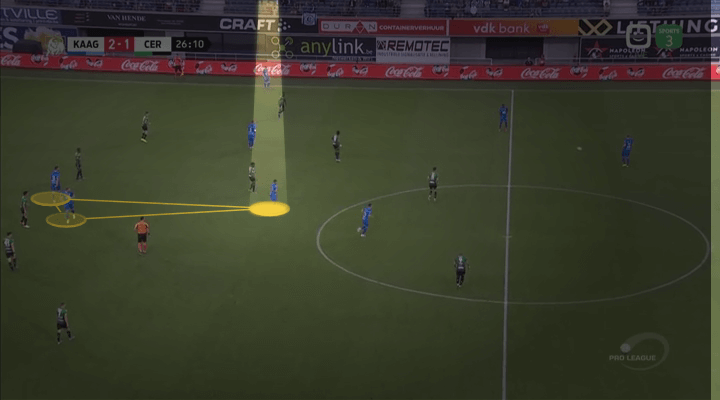
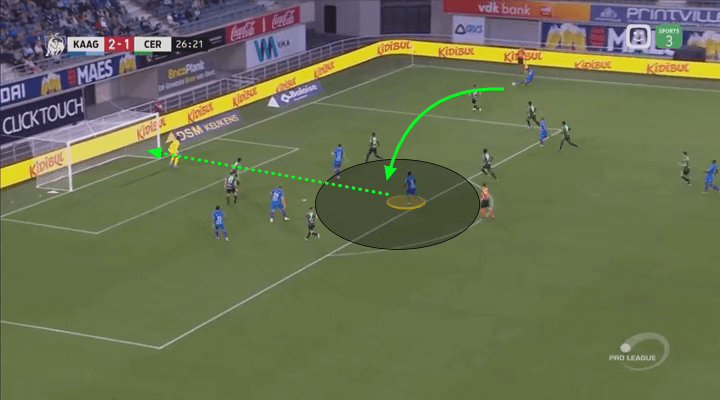
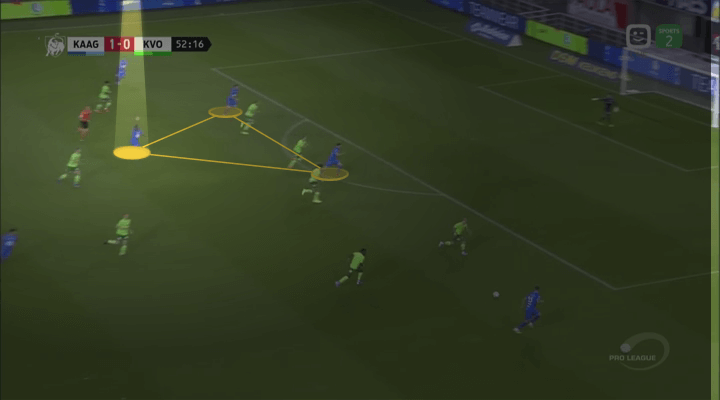
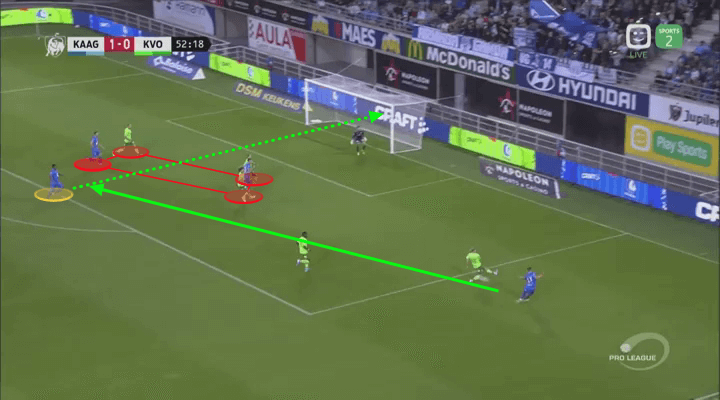
By taking another look at David’s heat map, it appears that the Canadian could also be defined as a raumdeuter. Raumdeuter is a German word which roughly translates to space investigator in English. High profile players who have been described as raumdeuters include Thomas Müller and Dele Alli. Such players are not typical number ‘9’ strikers, or typical number ‘10’ creators. These players look for space in advanced positions to hurt the opposition, rather than running beyond the defensive line or playing defence-splitting passes. In this sense, and the spread of his heat map across the offensive line in the final third and the penalty area, David could be described as a raumdeuter. Similar patterns can be seen when looking at Müller’s heat map, although, Müller tends to drift in from the right rather than move into the channels from a central position like David. However, given David’s goals have predominantly been as a result of late runs into the box, I believe the player is a more dominant shadow striker, with elements of the raumdeuter role within his play.

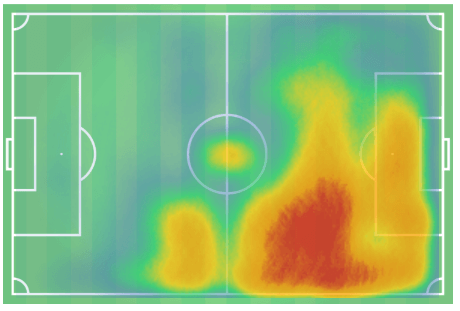
It would be interesting to see if David is asked or wants to play as a number ‘9’ consistently in the future. He is 5ft 10in, so whilst he would not be a dominative physical presence, it would be interesting to see how his movement and finishing ability would fair in a more advanced role. From a subjective view, the player looks to have adequate pace and the footballing knowledge in order to know when to make a run in behind or when to hold the ball up and link play. The player has done this for Gent when trusted up-front. Although, given the form he has been in for Gent over the 18/19 season, and the start of the 19/20 season in the shadow striker role, it is not expected for Gent to play David as an out and out striker.
While his time up-front is limited at Gent, David has played as a central striker for the Canadian national team, and with 11 goals in 10 appearances, he looks to have the ability to excel in that role. Although, a lot of his game time has also been spent on the right-wing. When playing on the wing, David has still utilised his ability to arrive in the box with space to receive the ball and finish.
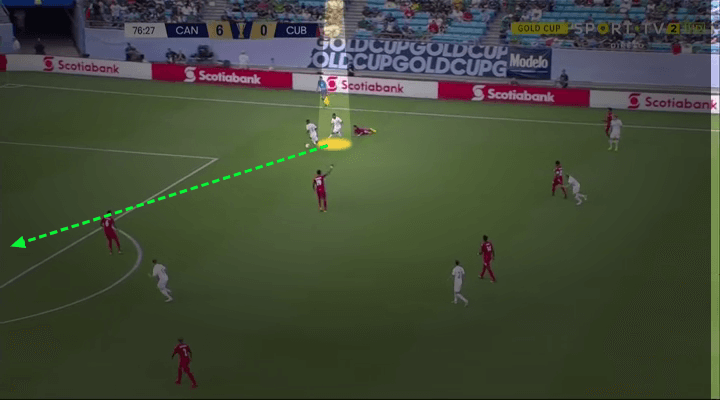
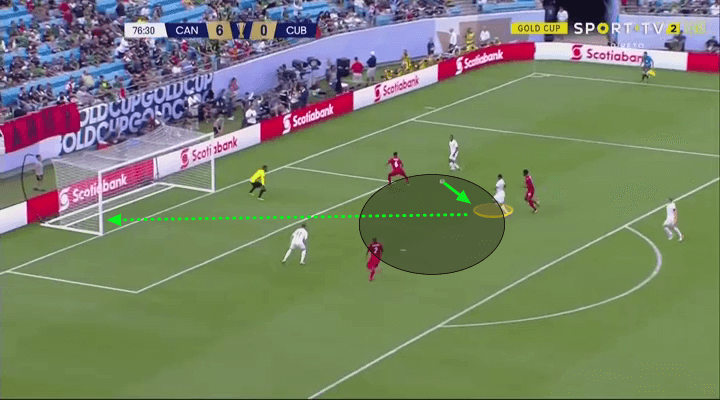
What else does he do? How does he compare?
We have identified that David is capable of scoring goals, and while that is the objective of football, it is interesting to analyse what David does when he isn’t scoring. His appraised assist count suggests that he is not a player to set up a teammate with a final pass, but is he involved in the build-up? Does he carry the ball well and beat a man? His use at right-wing for Canada would suggest so. Does he offer defensive contribution? And how does he compare against attacking midfielders and strikers? Such players are the most comparable players for David to benchmark against, although, his somewhat unique style of play means there are few players he can be directly compared with in terms of style.
| Player | Non-penalty goals per 90 | Assists per 90 | Crosses per 90 | Dribbles per 90 | Dribbles succ. % | Passes per 90 | Passes acc. % | Passes to penalty area per 90 | Thru passes per 90 |
| M. Samatta | 0.59 | 0.08 | 1.26 | 2.87 | 42.99 | 16.91 | 79.56 | 1.72 | 0.35 |
| J. David | 0.51 | 0.08 | 0.25 | 3.27 | 50.65 | 28.24 | 80.6 | 1.7 | 0.85 |
| Y. Boli | 0.38 | 0.06 | 0.32 | 4.08 | 50.78 | 22.81 | 81.84 | 1.15 | 0.54 |
| W. Togui | 0.37 | 0.09 | 1.65 | 4.78 | 50 | 20.41 | 72.97 | 1.75 | 0.18 |
| D. Mbokani | 0.34 | 0.18 | 0.34 | 4.97 | 54.32 | 17.02 | 78.2 | 1.66 | 0.49 |
| R. Emond | 0.32 | 0 | 0.22 | 0.45 | 28.57 | 10.81 | 72.11 | 0.38 | 0.16 |
| D. Okereke | 0.32 | 0.21 | 1.16 | 4.23 | 51.67 | 24.68 | 80.6 | 1.9 | 0.67 |
| I. Mboyo | 0.31 | 0.24 | 2.66 | 3.78 | 50.93 | 31.73 | 75.74 | 3.67 | 1.36 |
| C. Larin | 0.24 | 0 | 0.73 | 2.2 | 77.78 | 21.77 | 77.53 | 0.49 | 0 |
| S. Allagui | 0.23 | 0.11 | 0.69 | 3.09 | 40.74 | 22.07 | 71.5 | 1.43 | 1.37 |
| F. Forte | 0.2 | 0.1 | 0.44 | 1.32 | 44.44 | 12.21 | 75.2 | 0.73 | 0.15 |
| S. Berahino | 0.19 | 0.06 | 1.45 | 3.09 | 48.98 | 22.11 | 79.43 | 1.64 | 0.38 |
| Jon Bautista | 0.14 | 0 | 0.27 | 1.63 | 66.67 | 12.53 | 75 | 0.14 | 0.14 |
| F. Olinga | 0 | 0.14 | 2.5 | 7.63 | 58.18 | 25.4 | 81.15 | 2.29 | 0.56 |
The table above compares Jonathan David in terms of offensive contribution in comparison to other Belgian First Division A strikers. The table has been sorted in goals per 90 order. David is ranked second for this metric, suggesting he contributes better than the majority of strikers in the league. This is especially impressive given his most common shadow striker role in which he plays deeper than the majority of players in this list.
If we take a look at the other metrics, David performs with differing success levels. He is 13th for crosses per game, seventh and eight for dribbles and dribble success rate, third for passes per game and third for through balls per game. Overall his average rank is 6th, suggesting that as well as his goals, he successfully contributes to offensive phases of play and is one of the best performing strikers in the league, even, when not playing an out and out striking role.
| Player | Non-penalty goals per 90 | Assists per 90 | Crosses per 90 | Dribbles per 90 | Dribbles succ. % | Passes per 90 | Passes acc. % | Passes to penalty area per 90 | Passes to penalty area acc. % | Thru passes per 90 |
| I. de Camargo | 0.74 | 0.05 | 0.26 | 1.32 | 28 | 18.3 | 71.76 | 0.69 | 30.77 | 0.58 |
| J. David | 0.51 | 0.08 | 0.25 | 3.27 | 50.65 | 28.24 | 80.6 | 1.7 | 57.5 | 0.85 |
| L. Refaelov | 0.23 | 0.1 | 2.43 | 4.17 | 46.51 | 31.8 | 79.96 | 3.07 | 57.89 | 1.2 |
| R. Morioka | 0.18 | 0.06 | 1.03 | 2.98 | 65.31 | 37.19 | 79.74 | 3.71 | 52.46 | 2.73 |
| M. Bakić | 0.08 | 0.08 | 1.22 | 1.86 | 46.94 | 45.09 | 85.09 | 2.51 | 63.64 | 1.14 |
| S. Peeters | 0.06 | 0.06 | 1.27 | 1.21 | 68.18 | 48.78 | 81.9 | 2.43 | 43.18 | 1.6 |
| A. Ajagun | 0 | 0.08 | 1.89 | 1.73 | 50 | 36.69 | 77.9 | 2.91 | 56.76 | 1.81 |
| A. De Bruyn | 0 | 0 | 1.34 | 5.89 | 50 | 44.73 | 84.43 | 1.34 | 40 | 0.8 |
If we take a look at comparisons with central attacking midfielders in the table above, David is again ranked second for goals per 90. In the other metrics, there is again differing performance. David is ranked third for assists per 90, this is interesting as a performance metric which seemed low on the first review, is actually better than the majority of the creative midfielders in the league, again highlighting the quality of David’s contribution. He is once again ranked low for crossing, although, in his position, this should not impact upon performance. David dribbles well having ranked third for count and success rate, highlighting his ability with the ball and reinforcing the decision of Canada to play David out wide. It would be interesting to see how he performed in such metrics against natural wingers. David is, however, ranked seventh, sixth and sixth for passes, passes into the area and through balls, respectively. This suggests that the compared players do have more of an impact in general passing play and build up. David’s average rank was 5th, suggesting, as discussed, successful ranks for some metrics, while others were less successful. However, overall, these players are the most successful attacking midfielders based on Wyscout rankings, therefore, to be included in this sample suggests success to begin with.
| Player | Succ. def. per 90 | Def duels per 90 | Def duels won % | Aerial duels per 90 | Aerial duels won % | Tackles per 90 | Interceptions per 90 |
| R. Morioka | 6.38 | 8.75 | 59.03 | 1.46 | 41.67 | 0.67 | 3.34 |
| S. Peeters | 6.01 | 9.16 | 52.41 | 0.88 | 43.75 | 0.77 | 3.37 |
| M. Bakić | 5.09 | 7.6 | 53.5 | 2.24 | 52.54 | 1.25 | 2.43 |
| A. De Bruyn | 4.02 | 8.04 | 50 | 0.54 | 50 | 0 | 2.41 |
| I. de Camargo | 3.37 | 2.85 | 46.3 | 8.22 | 44.23 | 0 | 2.79 |
| L. Refaelov | 3.01 | 6.53 | 49.01 | 1.33 | 17.07 | 0.32 | 1.68 |
| J. David | 2.68 | 6.07 | 60.84 | 2.59 | 24.59 | 0.04 | 1.53 |
| A. Ajagun | 1.89 | 3.78 | 52.08 | 1.02 | 30.77 | 0 | 1.57 |
If we take a look at the defensive contributions of Jonathan David and his central attacking midfield comparatives, we see that David does not contribute as much as others in defensive phases. He is ranked seventh for successful defences, sixth for defensive duels, albeit his duel success is ranked the best, suggesting that when he battles for the ball, he wins the duel over 60% of the time. The final metrics do not favour David. He competes in the second-most aerial duels but has the second-worst success rate. He rarely puts in a tackle, hence his low figure and 0% success and his interceptions are ranked the worst of the sample. Overall, it is clear that while David clearly has talent going forward and the eye for goal, but could work on his defensive contributions to add to his overall game. This will no doubt be an area of work for the player, given he is still 19 years old and still learning his trade in the professional game.
19/20 season
So far, in the 19/20 season for Gent, David is one of the top performers in the league for goals involvement with six goal involvements via four goals and two assists. David is second, only ranked behind Dieumerci Mbokani of Antwerp who has five goals and three assists. However, once again, David is outperforming against his expected metrics. Looking at goals and assists combined, David could have realistically expected to be involved in two goals with an expectation of 2.29. Instead, David has six goal involvements, once again, exceeding the expectation. As stated before, it will be interesting to see if he can maintain such over-performance throughout the season. If David was involved in the two goals as expected, his record of two goal involvements in five matches could still be looked upon with success depending on his targets, but it is not as impressive as six in five matches.
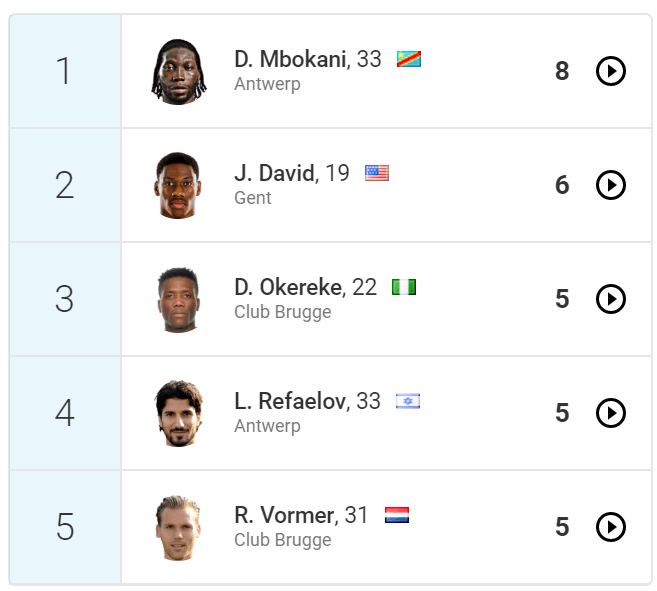
Conclusion
Overall, David is an exciting prospect who has produced multiple impressive performances in recent months. Given his recent rise into professionalism, his adaptation to life and football in Belgium have been seamless. He is scoring goals, albeit at a rate above the expectation, so regression may occur, and is doing so from a shadow strikers position. Given his young age, his tactical and spatial awareness, timing and finishing are very good, with versatility in regards to which position such skills are utilised in. The player ranks well when compared to out and out strikers in the league and also holds his own against attacking midfielders, although his role leads to slightly less involvement in build-up phases. Defensively the player could offer more. However, at 19 years old, the Canadian has established himself as one of the most threatening attacking players in the league. A continuation of his rise in skill, performances and reputation will surely lead to him attracting attention and offers from major European leagues. For now, Canada and Gent have got a very effective young player within their squads.

If you love tactical analysis, then you’ll love the digital magazines from totalfootballanalysis.com – a guaranteed 100+ pages of pure tactical analysis covering topics from the Premier League, Serie A, La Liga, Bundesliga and many, many more. Buy your copy of the August issue for just ₤4.99 here.





Comments